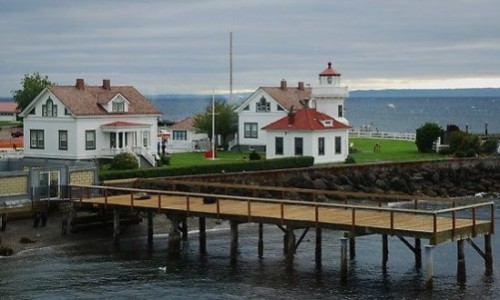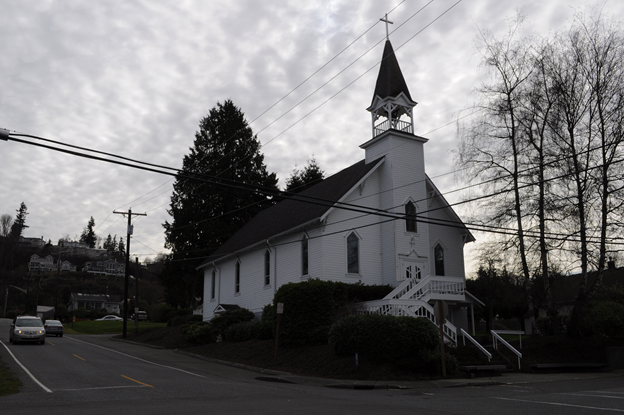By Kieran Gamble, MHS 2020 Scholarship Winner
Note: This is the winning essay submitted for the Mukilteo Historical Society’s 2020 scholarship program. Kieran Gamble is a graduating Kamiak High School senior who plans to attend the New York Film Academy in Los Angeles starting this fall.
Mukilteo is a small town rich in history. In 1855, Governor Isaac Stevens met with the 82 different Native American leaders in the area resulting in the Snohomish Tribe, who inhabited what is currently Mukilteo, signing the Point Elliot Treaty. In the Snohomish Tribe language “Mukilteo” meant two different things, one being good camping ground, as Mukilteo was a fishing village for the Snohomish and its neighboring tribes, and the other meaning narrow passage. The name Mukilteo was fitting because the town was located on a narrow passage of water that connected the Puget Sound and a big lake in the middle of town, which currently is the beach parking lot and a portion of old town.
Like other small towns in the area at the time, local leaders such as Emory C. Ferguson, Morris Frost and Jacob Fowler were trying to establish an empire with logging, trade business and hotels to encourage and support local growth.
Sense of community and spiritual growth is important when establishing a new city. Between 1907 and 1919, several churches were built to service the spiritual needs of the people. In 1907, a Presbyterian Church was built. Next was the Christian Missionary Alliance church in 1915. In 1916, the Nazarene Church was built. In 1919, a chapel initially referred to as the Church of the Holy Rosary, later to be known as St. John’s church, was constructed. St. John’s is currently the oldest active church in the city and is celebrating its 100th year since its official dedication in 1920.
Before St. John’s was constructed, the small Catholic community consisting of approximately 83 people worshipped in a building on 2nd Street in Mukilteo. There was a chaplain from Providence Hospital in Everett that attended the mission during 1908 through 1915. Due to the chaplain, the mission associated itself for a period of time with Perpetual Help located in Everett.
St. John’s was constructed at a total cost of $4,238.17. A local supporter in the community, Mary C. Mahoney, provided a grant of $500. An additional $500 was received in December 1919 by the Catholic Church Extension Society of the United States of America located in Chicago. In total, by August 1920 the community collected the additional funds needed to pay off the remaining $3,238 in construction costs and to purchase adjacent land to the church. The church was built by the community and for the community without any debt.
Father Leo Hansen said the first Mass on Christmas Eve in 1919, but it was not until August 20, 1920 that the church was officially dedicated with a high Mass officiated by Father O’Brien. Approximately 20 local children made their first Holy Communion during the Mass. The church was completely filled with visitors from Everett and other surrounding towns. After the services, a dinner was served for approximately 200 people by the ladies of the parish in the beautiful garden of Mr. and Mrs J. A. Cameron.
For four years from 1923 through 1926, Saint John’s congregation was served by priests that traveled all the way from Saint Martin’s Abbey in Olympia. From 1928 to 1932, Father Edmund Long was St. John’s priest. Father Long walked each Sunday to church from his home, the McNab Hogland house which, at the time, was an Ursuline convent. During this time St. John’s opened its doors to the greater Mukilteo community in times of need. When the original Rosehill School burned down in 1928, their classes were held at Saint John’s as well as Hawthorn Hall, now the Boys and Girls Club. The Mission also helped the greater community when Crown Lumber closed down and the Powder plant exploded in 1930. This was during the Great Depression which impacted the entire Mukilteo community.
Despite the loss of the lumber industry in Mukilteo, other industries that started at the same time still were present and growing. Transportation was something that was very important, as Mukilteo was cut off from other parts of the mainland. Boats became very popular in the area, as that was the number one way of getting into town. During this time of transition between the focus on lumber to transportation, Father William Fitzgerald guided St. John’s in 1936 to become attached to Immaculate Conception Parish in Everett. Father Fitzgerald was the priest until the early 1950’s.
Mukilteo saw a surge of growth when the United States entered into the second World War. In 1936, Paine Field was originally a commercial airport that provided another entry point into Mukilteo other than by boat. When Pearl Harbor was attacked in 1941, Paine Field was turned into an Air Force base. The government bought out the Mukilteo Lumber Company’s old lumber yard and built ammunition testing sites to help train soldiers for the war. The US government used Mukilteo to train approximately 600 soldiers until 1946.
In early 1940’s, Saint John’s children received their Catechism instruction in the basement of the mission, as well as in the homes of parishioners, attended by the Sisters at Immaculate Conception. The priest at the time was Father Bennan, who also served at Paine Field for soldiers during the second World War. Due to the war effort, St. John’s church was a place that drew many Catholic soldiers and employees of The Boeing Company to its doors.
The Boeing Company experienced significant growth with their plane manufacturing during the war effort. The Boeing Company brought many jobs and people to the city of Mukilteo during this time.
In the 1960’s, The Boeing Company began to build commercial airplanes like the 737 and 747. The Boeing Company has become one of the biggest companies in Snohomish county and continues to impact the city of Mukilteo’s economy.
St. John’s Church has played a big part over the past 40 years in my family’s history. In 1983, my grandparents and mother moved to Mukilteo from eastern Washington. With their Catholic background, they were drawn to attend the quaint little church. My mother received her Catholic Confirmation there in 1986. In 1999, my parents were married inside St. John’s church. My brother and I were baptized at St. John’s in the early 2000’s. My first years as a child, I went to church at St. John’s with my grandparents. Ironically, the priest at the time was Father Thumbi, the priest I altar-served with for four years at St. Thomas More church in Lynnwood. Even though I am not a consistent attendee at St. John’s, it is rare for my grandparents to miss a Sunday at church. Both my grandparents serve St. John’s in various ways. My Grandpa has helped over the years with maintenance and supporting fundraising events. My Grandma is an Eucharistic Minister and is a part of the Women’s Guild which oversees the church events, plants, funeral support, decorations, etc.
St. John’s has a solid place in the history of Mukilteo. It has served and supported the community for 100 years, not only in a religious capacity but as a fixture in the well-being of the town as a whole. I feel very fortunate and proud to be a part of this community and to have been a part of St. John’s my whole life.
Originally published in the 6/24/2020 issue of the Mukilteo Beacon.

